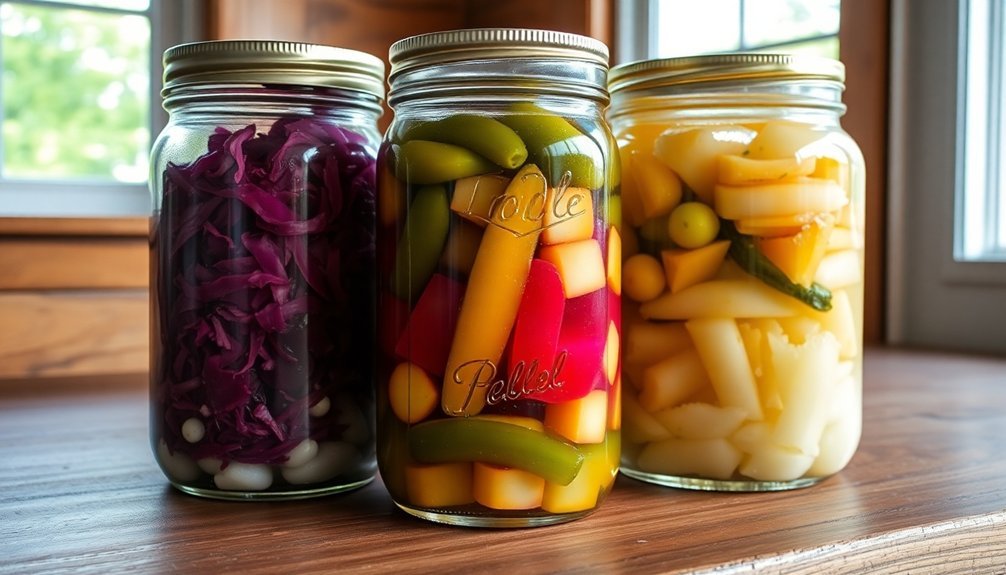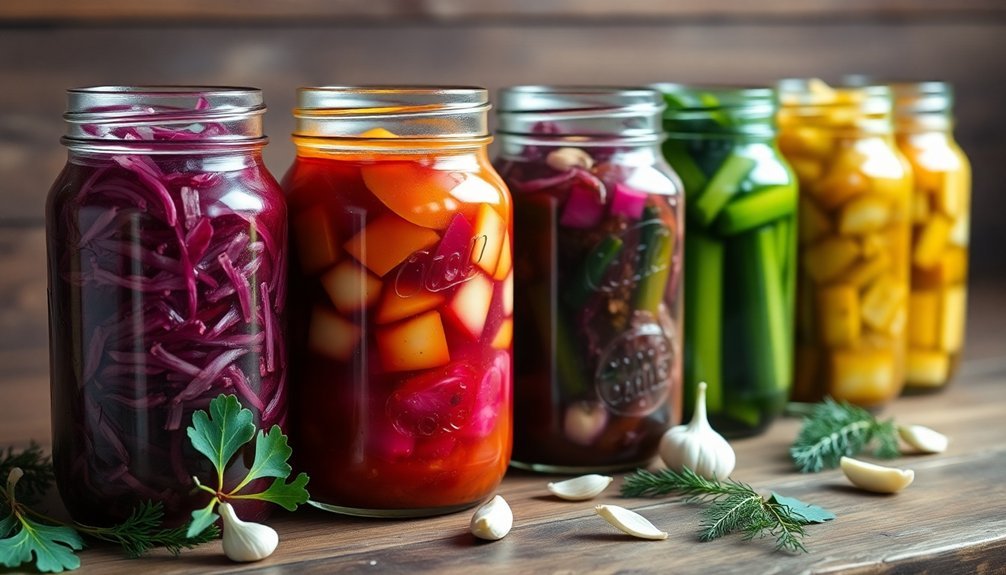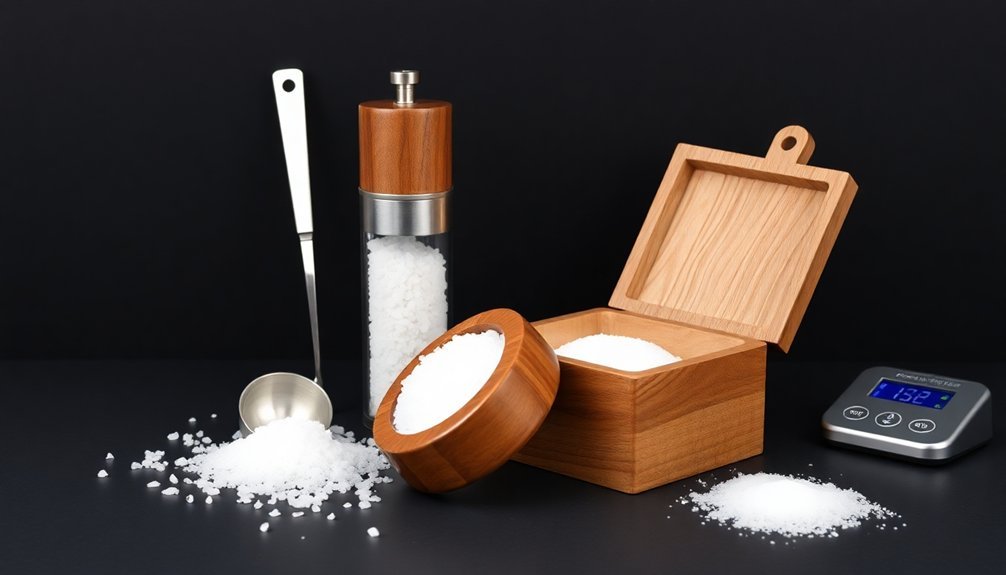You can easily make nutrient-rich fermented foods at home to boost your gut health and immune system. Start with beginner-friendly options like sauerkraut, dairy kefir, or kombucha using basic equipment like glass jars and fermentation weights. Always follow safety guidelines by using clean tools, non-iodized salt, and fresh ingredients at peak ripeness. Keep vegetables submerged in brine and monitor daily for proper fermentation. Store finished products in the refrigerator below 40°F to maintain probiotic benefits. Whether you choose classic cabbage ferments or experimental combinations, these living foods offer a cost-effective way to enhance your daily nutrition. Let's explore the transformative world of home fermentation together.
Understanding Fermentation's Living Benefits

Transformation lies at the heart of fermentation, where living microorganisms create foods teeming with health benefits. When you consume fermented foods, you're introducing beneficial bacteria that restore balance to your gut microbiome while making nutrients more accessible to your body.
These helpful microorganisms break down complex sugars and starches, reducing the workload on your digestive system. The ancient civilizations relied on fermentation to enhance flavors and prevent food spoilage. You'll notice improvements in digestive issues like bloating, gas, and irregular bowel movements, as fermented foods help alleviate common IBS symptoms.
They're particularly effective because fermentation destroys antinutrients like phytates and lectins that can interfere with nutrient absorption. The process also enhances the bioavailability of essential vitamins and minerals, especially in foods like beans and legumes.
Your immune system gets a significant boost from fermented foods' high probiotic content. These beneficial bacteria help protect you against harmful pathogens like Salmonella and E. coli while increasing your body's antibody production.
You'll likely experience fewer common colds and faster recovery times when you do get sick, thanks to the increased levels of vitamin C, iron, and zinc in these foods.
Best Starter Foods for Beginners
Starting your fermentation journey doesn't have to be complicated, and plenty of beginner-friendly options won't overwhelm you. You'll find that dairy-based ferments like kefir offer an excellent entry point, requiring just powdered starter and milk at room temperature for 24 hours. Kefir's tart and fizzy texture makes it a unique alternative to regular milk.
If you're interested in vegetable fermentation, sauerkraut provides a straightforward introduction, needing only cabbage and brine.
For the best chance of success, consider these beginner-friendly options:
- Make dairy kefir for your morning smoothies or salad dressings – it's as simple as combining milk and starter, then waiting a day.
- Try basic sauerkraut by shredding cabbage, adding salt, and keeping it submerged in its brine.
- Create fermented salsa using common ingredients to extend your produce's life while adding probiotic benefits.
You can also start with fermented condiments that complement your existing meals. Fermented ketchup and horseradish offer familiar flavors with added probiotic benefits.
If you're feeling more adventurous, kombucha provides an engaging project that you can flavor to your taste during secondary fermentation.
Essential Equipment and Tools

A well-equipped fermentation kitchen requires several essential tools to guarantee successful and safe results.
You'll need proper containers, starting with wide-mouth glass jars or fermenting crocks that provide the ideal anaerobic environment. Mason jars are particularly versatile, while glass and ceramic containers prevent unwanted oxidation that can occur with metal vessels. Simple cleaning and maintenance make these containers easy to reuse for multiple batches.
For preparation, you'll want a vegetable tamper to pack down produce and release essential juices, plus a canning funnel to minimize mess.
Don't forget to include filtering tools like plastic sieves and nut-milk bags for straining cultures and fermented beverages.
Monitoring tools are vital for safety and success. You'll need airlocks and fermentation lids to release gases while maintaining anaerobic conditions, weights to keep vegetables submerged under brine, and pH strips to track acidity levels.
A reliable thermometer helps maintain ideal temperatures for bacterial growth.
For measurement and specialized tasks, invest in kitchen scales for precise ratios, flip-top bottles for fermenting drinks, and a Dutch oven for bread baking.
Add kraut weights to keep vegetables submerged and rice flour to prevent dough from sticking to proofing baskets.
Basic Fermentation Safety Guidelines
While having the right equipment sets the foundation for fermentation, proper safety protocols protect both your health and your creations. Start by thoroughly washing all food-contact surfaces, hands, and containers with hot water and detergent.
You'll need to select undamaged, uniformly sized vegetables at peak ripeness and use non-iodized salt in the exact amounts specified by verified recipes.
Creating and maintaining anaerobic conditions is essential for successful fermentation. Make sure you:
- Cover your vegetables completely with brine to exclude air
- Seal your fermentation vessel properly to maintain oxygen-free conditions
- Avoid disturbing the fermenting vegetables unnecessarily
Monitor your fermentation daily by checking for any off-putting aromas or unusual appearances.
Keep the vessel in a temperature-stable location, typically between 60-70°F for most vegetables. You'll want to track the pH levels until they drop below 4.6, indicating complete fermentation.
Once fermentation's complete, store your products in the refrigerator below 40°F.
Always handle fermented foods with clean hands and label them appropriately. If you're planning to make shelf-stable products, consider having them tested by a process authority.
Simple Homemade Fermented Recipes

Several basic fermented recipes provide an excellent entry point into the world of home fermentation. You can start with classic sauerkraut, which requires only cabbage, caraway seeds, and salt in an airtight jar. For variety, you'll find radish kraut offers similar benefits while working great in salads and sandwiches.
If you're interested in a mixed vegetable approach, try fermenting a combination of broccoli, radishes, and carrots. You'll need to submerge them in a brine of water and sea salt, adding herbs like dill or basil for extra flavor. Keep the vegetables weighted down with a cabbage leaf while they ferment at 68-75 degrees.
For probiotic beverages, you can make kombucha using a scoby culture, or try the simpler fermented ginger lemonade made with whey.
If you're drawn to dairy ferments, homemade kefir offers an easy starting point – just combine milk with kefir grains or powder.
For a protein-rich option, consider making tempeh by fermenting soybeans with a starter culture, creating a versatile meat alternative that's packed with probiotics and nutrients.
Frequently Asked Questions
Can I Ferment Foods if I Have a Compromised Immune System?
You shouldn't ferment foods if you're immunocompromised, as live bacteria and yeasts can pose serious health risks. Consult your healthcare provider first, and consider avoiding fermented foods entirely for your safety.
How Long Can Fermented Foods Be Stored Before Losing Probiotic Benefits?
You'll find most fermented foods retain probiotics for 2-3 weeks in the fridge. However, storage times vary: yogurt lasts 3 weeks, kefir several weeks, and properly stored kimchi or sauerkraut several months.
Why Do Some Fermented Foods Develop a White Film on Top?
The white film you're seeing is likely kahm yeast, which appears when there's too much oxygen, warmth, or insufficient salt in your ferment. It's not harmful, but you'll want to skim it off.
Can Pregnant Women Safely Consume Homemade Fermented Foods?
You shouldn't consume homemade fermented foods during pregnancy due to contamination risks. Instead, opt for store-bought, pasteurized versions or probiotic supplements to safely get the benefits while protecting your baby's health.
Does Taking Antibiotics Affect How I Should Consume Fermented Foods?
Yes, when you're on antibiotics, wait at least 2 hours between taking your medication and eating fermented foods. You'll want to gradually introduce these foods after completing your antibiotic course to restore gut health.
In Summary
You're now equipped to create delicious fermented foods that boost your gut health and immune system. Start with simple recipes like sauerkraut or kombucha, and you'll quickly gain confidence to explore more complex ferments. Remember to maintain clean equipment, use quality ingredients, and trust your senses when fermenting. With practice, you'll master this ancient preservation method and enjoy probiotic-rich foods right from your kitchen.





Leave a Reply